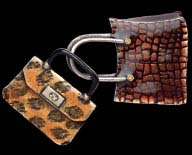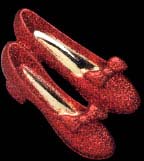Read My Pins (4 page)
Authors: Madeleine Albright

golden bee, St. John Knits.



Pins need not cost a king’s or queen’s ransom to be fun. These gifts from a friend were less than three dollars each.
Leopard and reptile print purses, AJMC; Ruby Slippers, AJC;

other designers unknown.


Petit Oiseau, Jacqueline Lecarme.
Because many of my predecessors had beards and none was known to wear a skirt, my use of pins to send a message was something new in American diplomacy. The role of jewelry in world affairs, however, began in ancient times. Throughout history, jewelry has played a supporting role in the rise and fall of empires. Although I might display to the world my less-than-extravagant pins, the global audience has long gaped in amazement at the stunning ornamentation of royal necks, waists, wrists, arms, and ankles—and at the accompanying crowns, thrones, scepters, and swords. To the victor go the spoils, and often those spoils have glistened with the radiance of diamonds or the soft glow of emeralds.
Although monarchs typically tried to hoard their treasure, the demands of politics often prompted them to make use of it. Early diplomatic practices included the exchange of ornamental gifts between one head of state and another, the gift of jewelry to cement marriages that brought two nations into alliance, and the flaunting of riches for the purpose of engendering awe.

FRANCESCO TREVISANI/ART RESOURCE
Laurel wreath, designer unknown.
Consider, for example, the story of one of the first international power couples: Marc Antony and Queen Cleopatra. According to the near-contemporary account of Pliny the Elder, Cleopatra wagered with Antony that she could spend an extravagant amount of wealth on a single dinner. He accepted the bet. The following
night, she served a meal of conventional dishes, to which he responded with triumphant disdain. Smiling at the vanity of her Roman suitor, Cleopatra ordered the next course to be brought in: a single cup of strong vinegar. Deftly removing one of her priceless pearl earrings, the queen dropped it into the vinegar, causing the gem to dissolve.

FRANCESCO TREVISANI/ART RESOURCE
Antony and Cleopatra at table. The pearl is about to drop.
The Banquet of Marc Antony and Cleopatra
, by Francesco Trevisani (1656–1746).

Byzantine shield, Ilias Lalaounis

circle of pearls, Craft.
A millennium later and several thousand miles to the north, a less elegant effort to connect the fates of two kingdoms was attempted. Olaf Tryggvason, the warrior king of Norway, set out to woo Sigrid, the comely queen of Sweden. Both had had previous romantic entanglements. Olaf had murdered a local rival named Iron Beard, claiming his victim’s daughter for a wife. The daughter, displeased with the arrangement, spoiled the honeymoon by stabbing Olaf in bed. Divorce ensued. For her part, Sigrid had grown weary of two boorish suitors. One night, she allowed the duo to drink themselves into unconsciousness before locking the beer hall and torching the building. Thereafter, the queen was known as Sigrid the Strong-minded.

Bird with pearl, Bettina von Walhof.
The betrothal of Olaf and Sigrid made sense diplomatically at a time and in a region where those without allies rarely prospered. Thus the queen was willing and the king eager enough to send his
prospective bride a beautiful gold ring. Sigrid’s fancy, though, was of the type bred more in head than in heart. She promptly sent the ring to her goldsmiths for appraisal. The experts had only to lift the object to know there was something rotten in Norway; sure enough, the gold band on the outside concealed copper on the inside. In diplomacy, as in love, cheapskates rarely prosper. Olaf’s ring was rejected, and Sigrid married the king of Denmark.
